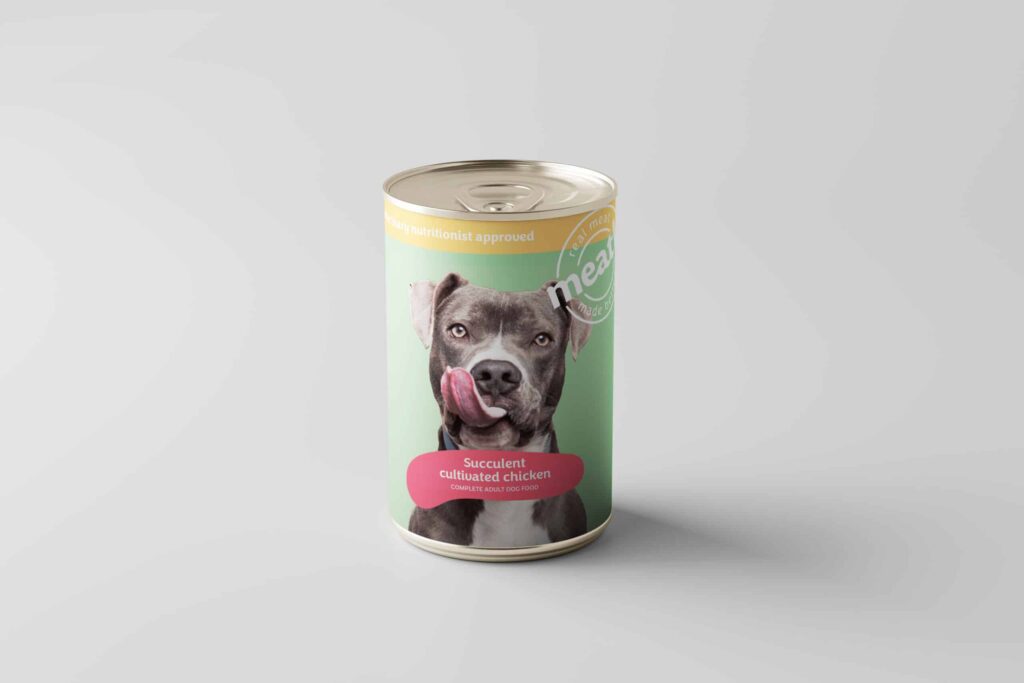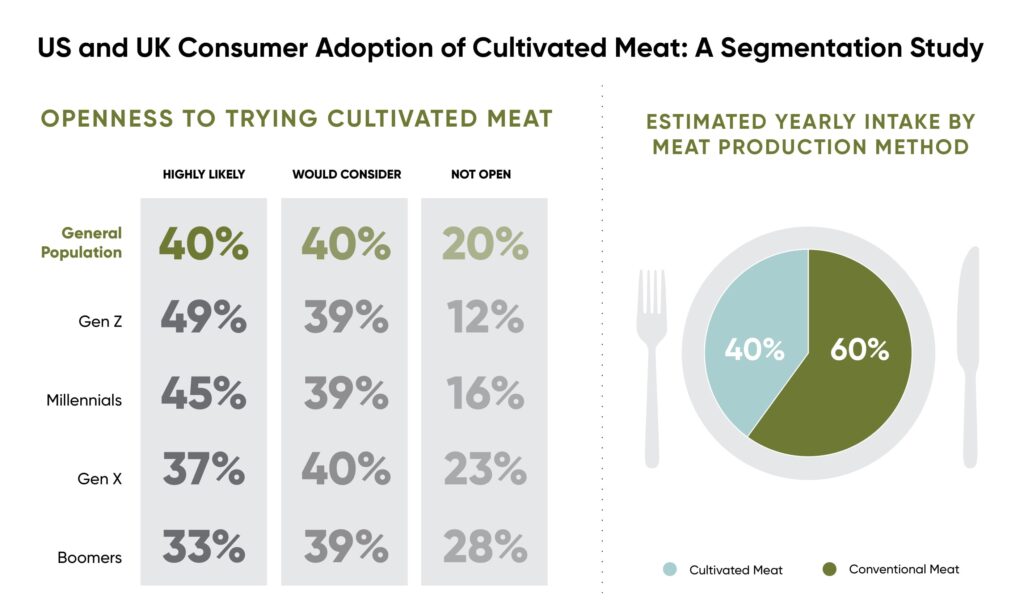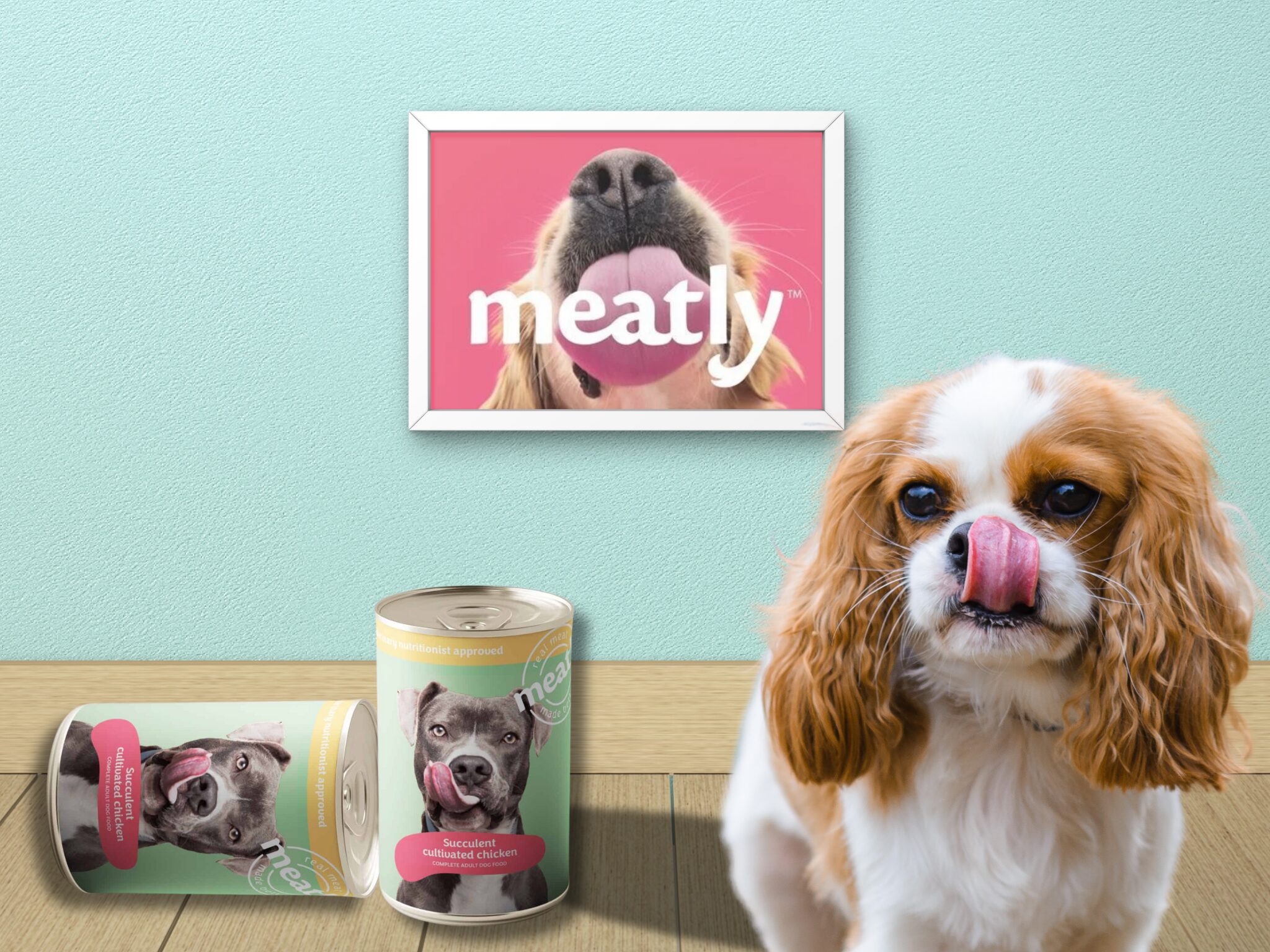Pet Food Startup Meatly on Cultivated Meat: ‘Changing Food Habits Transcend Politics’
12 Mins Read
Meatly CEO Owen Ensor and CSO Helder Cruz take us behind the scenes of the UK’s regulatory process for cultivated meat, and reveal that it will start with dog food first.
As the UK speeds up its novel foods regulation process, Meatly is on the brink of what would be the first regulatory approval for the sale of cultivated meat in all of Europe.
But the London-based startup isn’t making food for humans – instead, it’s producing cultivated chicken for pets. In March, it was reported that the company was expecting to get the greenlight in about three months with tinned cat food co-created with fellow British company Omni.
Meatly (formerly Good Dog Food) has since changed direction for its first product launch, as its co-founders Owen Ensor and Helder Cruz tell me in a wide-ranging conversation.
Ahead of the company’s debut on UK shelves, its team goes behind the scenes of the regulatory process, explains why a protein-free culture medium is the key to affordable cultivated meat, outlines the importance of humanising cultivated meat, and illustrates why hybrid meat is the way to go.
How the UK’s regulatory process works

Since its inception in 2022, most of the time has been spent on R&D and getting operations running. But one thing that was important to Meatly engaging with the regulatory authorities right from the beginning “to explain to them what we’re doing, and what approaches might make [the] most sense”.
“The pathway wasn’t entirely clear. And we’ve helped kind of clarify that and work with regulators to establish that,” says CEO Ensor.
He explains that there are two different phases for novel food approvals in the UK. “There’s the stage with the Food Standards Agency, where you need to understand whether this’ll be an additive or feed material. And then there’s a process with Defra, which is the Department for Environment, Food and Rural Affairs,” he says. “And with that, it’s about animal byproducts, legislation, which risk category this is in, and how your facility should be treated.
Meatly has been in consultation with the FSA for 18 months, and clarified that its pet food ingredient is a feed material with no genetic modification. As for the animal byproducts approval from Defra, that dossier was filed in August 2023.
There was a bit of controversy about feed materials after Czech cultivated pet food startup Bene Meat had listed its product on the EU Feed Materials Register in November. It was initially misconstrued as an official regulatory approval, but what it meant was that the startup’s product was now officially classified as a feed material.
The FSA’s regulatory overhaul and upcoming UK election

The UK retained EU regulations post-Brexit, but is now finally breaking away and speeding up its own process. The FSA is now set to announce a sliding-scale mechanism for novel foods approval that will take into account products’ track record internationally.
“We’ve been engaging the FSA very closely, with a big scientific contingent in the FSA coming and visiting our lab. And they’re very supportive of what we’re doing and other people in the industry are doing,” says Ensor.
“They’re looking to create this sandbox – so get central government funding to really commit to a cultivated meat pathway. I think that will really help. I think they’re being very intentional and careful about how they legislate and regulate cultivated meat, which is great to see them putting that thought in.
“I think all the cultivated meat for human food companies are just kind of waiting for a clear pathway. And it might still take a bit of time for them to establish that. But it’s great to see how engaged and enthusiastic they are being about it… You see biotech as a key strand in the UK government’s economic strategy, and so I think that will continue.”
On that subject, the UK this Thursday will head to the ballots to vote in its national election, with the Labour Party expected to form a government for the first time in 14 years. Does the election impact Meatly’s regulatory process at all?
“I don’t think so. I think we’re far enough down the line that the pathway has been established. And we’re now in the more nitty gritty aspects of site inspections and that kind of stuff,” Ensor suggests. “I think the long-term trends transcend daily politics. Everyone kind of wants to move to a more sustainable food system. Everyone wants healthy food for themselves and their pets.
“And I think the trends in alternative proteins – and cultivated meat in particular – fit with that perfectly. And so I don’t expect any major hiccups.”
When pressed on the timeline for approval, then, Ensor says Meatly hoped to be cleared around the election, whether that’s “weeks before or weeks after”. “I have a strong confidence level [that] it will be this summer… whether it’s July, whether it strays into early August, I hope it doesn’t go beyond that. But I think that’s the window,” he tells me.
A protein-free media for cheaper cultivated meat

One of the major bottlenecks of cultivated meat is the cost associated with producing it. Meatly claimed to have slashed this significantly by developing a protein-free culture medium for its pet food. While these media usually costs hundreds of pound (and make up the most expensive part of cultivated meat production), the British company brought it down to £1 ($1.25).
“Protein-free media in biopharma is not kind of new, but in cultivated meat is,” says Cruz, who is Meatly’s chief scientific officer. “And it depends also on the type of cells on the species – some are a bit more challenging than others.” From the beginning, Meatly had an objective to ensure that everything it does is “realisable, cost-effective, and food-safe.
“We had the experience of working with protein-free media before, although – I don’t want to be negative – there’s lots of noise around the media and the cells and so on. But depending on the cell types and the species, you can grow them very well, without any protein.”
He adds that growth factors aren’t going to become 1,000 times cheaper to make cultivated meat really affordable, which is what prompted Meatly to take this approach.
This has lots of advantages when it comes to cost and quality controls, explains Cruz. “But in the composition of the cells, not so much,” he adds, touching upon the nutrition aspect. “Of course, we can always play with some nutrients, but not necessarily proteins, to finetune the composition – like fatty acids, some amino acids and so on.”
But the functions of proteins that are absent from the medium can be replaced by small molecules that are safe and affordable, he says.
“We’ve done a lot of nutritional analysis, safety analysis on the product,” Ensor chimes in. “It shows as a very similar nutritional profile to chicken breast and has all of the essential amino acids, fatty acids, minerals and vitamins that cats and dogs need to thrive.”
Meatly to begin with cultivated dog food

Asked if the new culture medium could open up a potential revenue stream as a licensor, Ensor said: Media is notoriously challenging to patent and protect from an IP perspective, because it’s very difficult to prove someone’s using the same media and quite easy to circumnavigate, which are two challenging aspects.
“We have other kinds of key IP pillars that we might look to licence sooner than the media. Down the line, we’ll look to licence a full factory solution, using ourselves and the equipment and processes that we’ve developed.”
Does changing the growth media also affect how quickly cultivated meat can be made? “When you start developing media, cells sometimes slow down a little bit, but you need to adapt them. So it’s all about the execution. And the time it takes at the end, the performance is the same as in expensive media,” says Cruz.
Meatly is now solely producing with the protein-free media in its bioreactors. Currently, it’s producing between five to 10 kgs per month – this capacity is 50 times what it was 18 months ago. And although still not mass-production level, this is enough to begin testing the cultivated chicken in pet food formulations.
While the startup has already shipped samples to partners who are creating prototypes and conducting initial production runs with the previous culture medium, any fresh biomass created for Meatly’s product launch will be with the protein-free version.
Currently, it has cells of one species, which can be an ingredient for both cat and dog food. “We’re seeing very good results, very similar performance,” says Ensor. Speaking of which, when Meatly’s impending approval was first announced, it was meant to be a cat food product that would cost £1.50 per 150g can. But now, the company will first roll out dog food instead.
“We’ll see whether we want to launch additional products after that,” he says. “We might just stick with the dog food.” Asked about the cat food product, he adds: “It depends on the manufacturing capacity… That’s part of the product development and prototyping we’re doing at the moment, deciding which we launch with, and how much emphasis we put on either of them, or both.”
This will likely feature a different partner than Omni, and while the CEO wouldn’t be drawn on a name, it is “one of the UK’s leading dog food brands”, he offers.
Hybrid meat shows a lot of promise

Currently, most cultivated meat that has been served to customers or taste-testers has been a hybrid product combining cultivated animal cells and plant-based ingredients, in an effort to tackle the scale-up challenges and lower the costs.
This was illustrated best by Eat Just (the world’s first startup to be allowed to sell cultivated meat), which debuted a new version of its Good Meat chicken in retail in Singapore. This edition had 3% cultivated cells, compared to 60-70% for its previous chicken (which was sold in foodservice).
Meatly’s cultivated dog food will be hybrid too. “What you find typically in pet foods, the meat content… depending on the brand, is typically in that 20-30% window. We’ll probably start slightly lower just because of limited supply,” suggests Ensor.
“But even at lower inclusion rates, that has a great palatability impact. So acceptance of the food is increased, it adds some of those key nutrients, and we can advertise it as having chicken in the recipe.”
One of Meatly’s key partners has been Pets At Home, the UK’s leading pet retailer, which invested in its last fundraising round. “They’re incredibly forward-thinking and focused on what the future of this industry looks like,” Ensor explains. “We’re not currently looking for other retail partnerships in the UK, because Pets At Home is the pinnacle.”
Looking internationally, the brand is exploring collaborations in North America too, currently conducting R&D with a pet food manufacturer there. It may look at retail agreements too, but Meatly doesn’t expect to launch in the region at least for the next 18 months, mainly due to production reasons. “We’re just kind of building those R&D relationships where we can have strategic players that we might want to work with in the future,” says Ensor.
Alongside North America, the EU is another market Meatly is keeping an eye on, but where it heads next will be “largely dictated by regulatory barriers”. “North America is likely to be most attractive – so both Canada and the US – to probably go there next, and then come back across to the EU. Once hopefully, there’s a bit more of a streamlined process established there.”
Meatly to close Series A fundraise soon

Meatly has raised £3.6M to date, much lower than many of its counterparts across the world. The startup is now raising a Series A round – but it comes after a year where investment in cultivated meat dipped by 74%. And in the first quarter of 2024, only $12M was injected into startups in this sector.
“We’ll be closing [the Series A] the summer,” says Ensor. But it won’t be a huge raise. “We want to continue to show that there is a low capex, fast way to commercialise profitable cultivated meat, and so we’re not looking at monster fundraisers.
“We’ll use that to continue our R&D efforts. And really, you know, there’s a lot of information out there about cultivated meat. But when you boil it down, there are a couple of key factors, which are your media cost, your yield, and your capex costs. This additional capital will continue to focus on those and basically minimising the cost base as much as possible before we start scaling up.
“As we look at the industry, that’s kind of what we describe as ‘wave one’ companies, which are those that raise a lot of capital, went very hard on scaling fast, but have hit roadblocks with that. And then ‘wave two’ companies, like Vow, us, who have raised less capital and found creative routes to find a low-cost, fast way to scale.”
Tackling consumer acceptance

Ensor notes that while surveys have shown consumers to have an interest in cultivated meat – a third of Brits were open to trying it even in 2022 – there are some hurdles to overcome.
“No one has ever really explained to a consumer what this is, how it’s made and what the benefits are. There is an education step and an explanation step,” he says. “Whenever we’ve explained to people that this is a safe, healthy, sustainable and kind way of feeding us and our pets, and [that] we don’t use antibiotics or steroids or hormones, there’s no contamination risk, there’s no GMOs involved – that goes a long way to providing people reassurance.”
Ensor continues: “We’re not going to convince everyone [from] day one. It is a process, but we have all the information, we can make clearly make those points to people, and I hope that they will be receptive to that. And again, I think these trends of wanting to move to a healthy, sustainable and kind food system transcend people’s politics or perspectives.”
Is the consumer messaging something Meatly will be focusing on with the new capital and its packaging “We’re not gonna have significant capital towards that. We’re a B2B player, so the specific packaging and messaging will depend on the manufacturer,” outlines Ensor. “But certainly, we’ll want to emphasise those points.”
He points to how cultivated meat has become part of the culture wars in the US (where two states have banned it), with politicians painting a picture of people in lab coats and talking about the “global elite”.
Ensor says: “One of the other things we’re thinking about doing is just humanising cultivated meat more… from an individual perspective and why we’re passionate and excited about it.”



